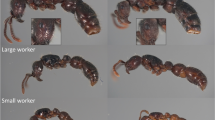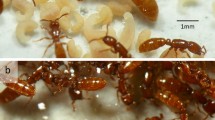Summary
Ropalidia ignobilis dwells in small colonies of 100 or fewer contemporaneous adults, founded by one or a few females. Variation in size is continuous when a number of colonies are combined, yet each colony produces females in two discrete morphological castes. Nest architecture shows that workers abruptly switch from producing small to large larvae. Large females apparently fulfill the role of the dominant reproductive, but small females are not obligatorily sterile. Castes differ in size, allometric relationships between body parts, number of hamuli per mm. wing length, and coloration in a fashion consistent with what is known for more advanced dimorphic species of social wasps. This dimorphism, rare in Polistinae and previously unknown in small-colony, independent-founding species, challenges our understanding of the evolution of advanced insect sociality.
Similar content being viewed by others
References
Blackith, R. E., 1958. An analysis of polymorphism in social wasps.Ins. Soc. 5:263–272.
Carpenter, J. M. and K. G. Ross, 1984. Colony composition in four species of Polistinae from surinam, with a description of the larvae ofBrachygastra scutellaris (Hymenoptera: Vespidae).Psyche 91:237–250.
Craig, R., 1983. Subfertility and the evolution of eusociality by kin selection.J. Theor. Biol. 100:379–397.
Dropkin, J. A. and G. J. Gamboa, 1981. Physical comparisons of foundresses of the paper wasp,Polistes metricus (Hymenoptera: Vespidae).Can. Entomol. 6:457–461.
Gadagkar, R., 1980. Dominance hierarchy and division of labour in the social wasp,Ropalidia marginata (Lep.) (Hymenoptera: Vespidae).Curr. Sci. 49:722–775.
Gadagkar, R. and N. V. Joshi, 1982. Behavior of the Indian social waspRopalidia cyathiformis on a nest of separate combs (Hymenoptera: Vespidae).J. Zool., London198:27–37.
Gadagkar, R., M. Gadgil, N. V. Joshi and A. S. Mahabal, 1982. Observations on the natural history and population ecology of the social waspRopalidia marginata (Lep.) from peninsular India (Hymenoptera: Vespidae).Proc. Indian Acad. Sci. (Anim. Sci.)91:539–552.
Gadgil, M. and A. Mahabal, 1974. Caste differentiation in the paper waspRopalidia marginata (Lep.).Curr. Sci. 43:482.
Haggard, C. and G. J. Gamboa, 1980. Seasonal variation in body size and reproductive condition of a paper wasp,Polistes metricus (Hymenoptera: Vespidae).Can. Entomol. 112:239–248.
Hughes, C. and J. E. Strassmann, 1988. Age is more important than size in determining dominance among workers in the primitively eusocial wasp,Polistes instabilis.Behaviour 107:1–14.
Ishay, J., 1975. Caste determination by social wasps: cell size and building behaviour.Anim. Behav. 23:425–431.
Itô, Y., 1984. Social behavior and social structure of neotropical paper waspsMischocyttarus angulatus Richards andM. basimacula (Cameron).J. Ethol. 2:17–29.
Jeanne, R. L., 1972. Social biology of the neotropical waspMischocyttarus drewseni.Bull. Mus. Comp. Zool. 144:63–150.
Jeanne, R. L., 1980. Evolution of social behavior in the Vespidae.Ann. Rev. Entomol. 25:371–396.
Jeanne, R. L. and R. Fagen, 1974. Polymorphism inStelopolybia areata (Hymenoptera, Vespidae).Psyche 81:155–166.
Kojima, J., 1982. Nest architecture of threeRopalidia species (Hymenoptera: Vespidae) on Leyte Island, the Philippines.Biotropica 14:272–280.
Landolt, P. J., R. D. Akre and A. Greene, 1977. Effects of colony division onVespula atropilosa (Sladen) (Hymenoptera: Vespidae).J. Kansas Entomol. Soc. 50:135–147.
Litte, M., 1977. Behavioral ecology of the social waspMischocyttarus mexicanus.Behav. Ecol. Sociobiol. 2:229–246.
Litte, M., 1981. Social biology of the polistine waspMischocyttarus labiatus: survival in a Colombian rain forest.Smithsonian Contributions to Zool. 327:1–27.
Marino Piccioli, M. T. and L. Pardi, 1970. Studi sulla biologia diBelonogaster (Hymenoptera, Vespidae) 1. Sull'etogramma diBelonogaster griseus (Fab.).Monit. Zool. Ital. (N.S.) Suppl. 3, 31:197–225.
Pardi, L. and M. T. Marino Piccioli, 1970. Studi sulla biologia diBelonogaster (Hymenoptera, Vespidae) 2. Differenziamento castale incipiente inB. griseus (Fab).Monit. Zoo. Ital. ((N.S.) Suppl. 3, 11:235–265.
Richards, O. W., 1949. The significance of the number of wing-hooks in bees and wasps.Proc. R. Ent. Soc. London (A)24:75–78.
Richards, O. W., 1969. The biology of some W African social wasps (Hymenoptera: Vespidae).Mem. Soc. Entomol. ltal 48:79–93.
Richards, O. W., 1978a. The Australian social wasps (Hymenoptera: Vespidae).Aust. J. Zool. Suppl. Ser. 61:1–132.
Richards, O. W., 1978b.The Social Wasps of The Americas Excluding The Vespinae. British Museum (Natural History), London, 580.
Saussure, H., 1891. Histoire Naturelle des Hyménoptéres. In:Histoire Physique, Naturelle et Politique de Madagascar (A. Grandidier, Ed.), Vol. 20, Imprimerie National, Paris, pp. 1–590.
Strassmann, J. E., 1981, Evolutionary implications of early male and satellite nest production inPoliste exclamans colony cycles.Behav. Ecol. and Sociobiol. 8:55–64.
Strassmann, J. E., 1983. Nest fidelity and group size among foundresses ofPolistes annularis (Hymenoptera: Vespidae).J. Kansas. Entomol. Soc. 56:621–634.
Sullivan, J. D. and J. E. Strassmann, 1984. Physical variability among nest foundresses in the polygynous social wasp,Polistes annularis.Behav. Ecol. Sociobiol. 15:249–256.
Turillazzi, S., 1980. Seasonal variations in the size and anatomy ofPolistes gallicus (L.) (Hymenoptera Vespidae).Monit. Zool. Ital. ((N.S.) 14:63–75.
Turillazzi, S. and L. Pardi, 1977. Body size and hierarchy in polygynic nests ofPolistes gallicus (L.) (Hymenoptera: Vespidae).Monit. Zool. Ital. (N.S.) 11:101–112.
Wenzel, J., 1987.Ropalidia formosa, a nearly solitary paper wasp from Madagascar (Hymenoptera: Vespidae). J. Kansas. Entomol. Soc.60:549–556.
Wenzel, J., 1989. Endogenous factors, external cues, and eccentric construction inPolistes annularis (Hymenoptera: Vespidae).J. Insect Behav. 2:679–699.
Wenzel, J., 1991. Evolution of nest architecture. In:The Biology of Social Wasps (K. G. Ross and R. W. Matthews, Eds.), Cornell Univ. Press, pp. 480–519.
West Eberhard, M. J., 1969. The social biology of polistine wasps.Misc. Publ. Mus. Zool. Univ. Michigan 140:1–101.
West Eberhard, M. J., 1975. The evolution of social behavior by kin selection.Quart. Rev. Biol. 50:1–34.
Wilson, E. O., 1971. Caste evolution as a function of mature colony size in social bees and wasps. In:Entomological Essays to Commemorate. The Retirement of Professor K. Yasumatsu, Hokuryukan Publ., Tokyo, pp. 215–217.
Yamane, Sô., J. Kojima and Sk. Yamane, 1983. Queen/worker size dimorphism in an Oriental polistine wasp,Ropalidia montana Carl (Hymenoptera: Vespidae).Ins. Soc. 30:416–422.
Yamane, Sô., 1985. Social relations among females in pre- and postemergence colonies of a subtropical paper wasp,Parapoblybia varia (Hymenoptera: Vespidae).J. Ethol. 3:27–38.
Author information
Authors and Affiliations
Rights and permissions
About this article
Cite this article
Wenzel, J.W. Extreme queen-worker dimorphism inRopalidia ignobilis, a small-colony wasp (Hymenoptera: Vespidae). Ins. Soc 39, 31–43 (1992). https://doi.org/10.1007/BF01240529
Received:
Revised:
Accepted:
Issue Date:
DOI: https://doi.org/10.1007/BF01240529




